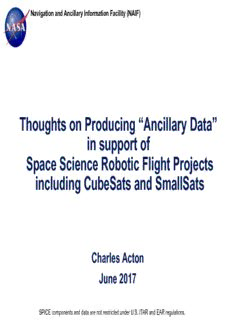Table Of ContentNavigation and Ancillary Information Facility (NAIF)
Thoughts on Producing “Ancillary Data”
in support of
Space Science Robotic Flight Projects
including CubeSats and SmallSats
Charles Acton
June 2017
SPICE components and data are not restricted under U.S. ITAR and EAR regulations.
Navigation and Ancillary Information Facility (NAIF)
Topics
• What are “ancillary data?”
• Why are such data needed?
• Approach and skills needed to produce ancillary
data files
• Information about the “SPICE” methodology for
producing and using ancillary data
• Backup material
Graphics Depicting SPICE Data
Contents of SPICE Kernels
Ancillary Data Production Challenges
Graphics Depicting How SPICE Kernels are Made and Modified
2
Navigation and Ancillary Information Facility (NAIF)
Caution Regarding Terminology
• This presentation uses terminology familiar to the
NAIF team. It could be that “our” interpretation
and “your” interpretation of a term are different.
3
Navigation and Ancillary Information Facility (NAIF)
What Are “Ancillary Data”?
• “Ancillary data” refers, at a minimum, to spacecraft
trajectory and spacecraft orientation (attitude)
• “Ancillary data” often also include some or all of:
– reference frame* specifications
– instrument mounting alignment and instrument field-of-view
specifications
– target body physical and cartographic constants
» size, shape and orientation
– data needed for time system conversions
• The next chart provides a pictorial representation
of ancillary data in the broad sense
*Outside of SPICE the term “coordinate system” is sometimes used instead of “reference frame”
4
Navigation and Ancillary Information Facility (NAIF)
A Pictorial of Ancillary Data
Orientation
Antenna and size/shape
reference of Earth
frame J2000 reference frame
(ICRF)
Sun
Spacecraft
Reference frames
Earth
•
Positions
Solar System Barycenter
Orientations
Sizes/shapes
Instrument
reference frame
Relative positions
Pointing
Spacecraft of spacecraft and
Time Conversions reference frame solar system bodies
Orientation
of spacecraft
Orientation
and
size/shape
of planet
Planet-fixed
reference frame
Pointing of
Instrument Planet
field-of-view
Time Conversion
Calculations 5
Navigation and Ancillary Information Facility (NAIF)
Purposes for Ancillary Data
• Help mission designers and scientists converge
on a mutually acceptable spacecraft orbit design
• Compute observation geometry parameters and
conditions needed by mission engineers for tasks
such as…
– communications station view period calculations
– communications station antenna pointing and tuning
– thermal and telecom analyses
• Compute observation geometry parameters and
conditions needed by science instrument teams
for tasks such as…
– science observation planning
– science archive preparation
– science data analysis
6
Navigation and Ancillary Information Facility (NAIF)
Contrast “Ancillary Data” and
“Observation Geometry”
Ancillary Data Observation Geometry
(Files) (Parameters)
Altitude = xxx km.
Latitude = xxx deg.
Longitude = xxx deg.
Phase angle = xxx deg.
Spacecraft trajectory
etc.
Some etc.
Software
Observation Geometry
(Conditions)
Spacecraft orientation
- Spacecraft is in occultation by Mars
-Altitude is at a global maximum
- Phase angle is in the range of 24 to 38
degrees
Spacecraft clock correlation
etc.
7
Navigation and Ancillary Information Facility (NAIF)
When are Ancillary Data Used?
A Minimal View
Science archive
preparation
Phase E Phase F
Launch EOM
Initial science Science archive
data analysis user support
8
Navigation and Ancillary Information Facility (NAIF)
When are Ancillary Data Used?
A More Practical and Common View
Mission concept Mission design Detailed science Science archive
development validation observation planning preparation
Pre Phase A Phases A -D Phase E Phase F
Launch EOM
Mission Mission operations Initial science Science archive
design support data analysis user support
Full Mission Lifecycle
9
Navigation and Ancillary Information Facility (NAIF)
What Approach Might Be Taken
to Providing Ancillary Data?
• Minimal approach–the project provides:
– a table of reconstructed, time-tagged spacecraft position vectors
– a table of reconstructed, time-tagged spacecraft orientation
quaternions
… with the above tables using UTC time tags (sometimes called SCET)
– The project leaves it to end users to use these data–probably some
other data as well–in conjunction with the user’s own-built software
to compute needed observation geometry parameters
• Maximal approach– the project provides a complete
“SPICE” capability as described later on
• Certainly other, middle-ground approaches exist
10
Description:bugs are rarely found. • Having proven, extensive .. Must be checked using real flight observations, since errors of 90 or 180 degrees often crop up.

